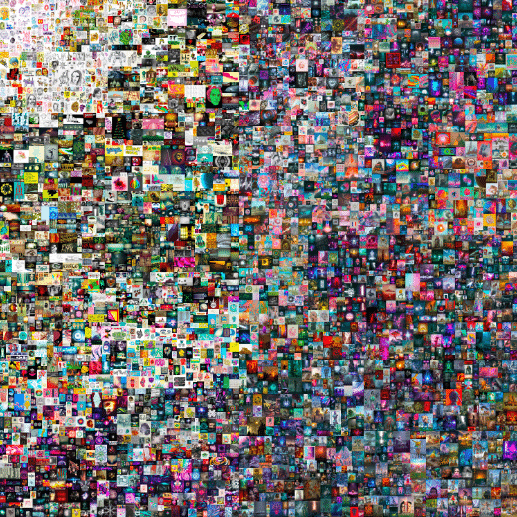‘NFT’ stands for non-fungible token; it is a crypto currency which is not able to be mutually exchanged but enables a virtual image (artwork) to be authenticated with a unique code by blockchain attached to it to be sold as unique, even if the same image exists elsewhere in the world (wide web). When you buy an NFT for an artwork online you are buying the token, not the work itself.

The buyer’s digital asset is verified and some artists (and celebrities) are winning big in this new peripheral art market.
Recently American artist Beeple, aka Mike Winkelmann, sold a work titled ‘Everydays – The First 5000 Days’ in Christie’s online auction for around $US70M, the third highest price achieved by a living artist, after David Hockney and Jeff Koons, and the highest (so far) for an NFT artwork. The work is comprised of 5,000 images the artist created everyday over a period of 13 years. Beeple has said that NFTs are a solution to legitimately collect digital art, and in this case the artist will receive a 10% royalty if the NFT is re-sold.

In this burgeoning marketplace there are contracts unique to each company between artist, platform and user so it’s important to know what features and terms are in the contract. And it’s also worth noting that while the concept puts authentication at its core there can still be problems. Some artists have reported copyright infringement with a ‘token’ being taken of/from a work posted on social media and then put up for sale on a platform.
Tokenised Tweets and Marblecards are NFT services which ‘tokenise’ existing digital content, enabling people other than the creator to sell the secondary source or token. Further, while some artworks are being authenticated, scarcity isn’t necessarily a cornerstone of the new marketplace. As with limited edition prints ‘in real life’, the artworks available through the various channels can be sold in verified mutliples.
Not having acquired an NFT myself I can’t articulate the complexity or value of the transaction but from initial research you’ll need several accounts (one for your crypto currency, another to exchange said currency and a wallet app) and this may vary across the different outlets for discovering NFT artworks.
Nifty Gateway is a marketplace with artists uploading and buyers making direct transactions as well as traders both purchasing and reselling works of art that the site refers to as ‘Nifties’. Nifties are tagged with (other than your typical artwork information) the ‘release date’, edition size, original price, average sale price and most recent sale price. Primary purchases are made using Ethereum (ETH) a cryptocurrency and Metamask (wallet app) where as other transactions can be done with a bankcard. Foundation is host to live auctions and “sell, purchase, list for auction, make offers, and bid (each a “Transaction”) on digital art”. The digital art on Foundation is also represented on smart contracts on the Ethereum blockchain and includes Metamask and Coinbase (a digital currency exchange). Other sites to check out include OpenSea, KnownOrigin, and Valuables (where you can buy NFTs of tweets…) These sites bill themselves as platforms with no responsibility to the third party services you access.
While NFTs exist in what feels like the ether it will be interesting to observe how artists passionate about creating in the physical realm respond to this opportunity that perhaps represents a break from the traditional commercial model. Maybe it will be taken up by digital or design centric artists who already have a skill set to navigate this market and potentially find less opportunity for representation in the ‘white cube’.
It is also worth noting that the environmental impact of using cryptocurrencies is arguably negative, as at present they require a huge amount of electricity to exist and be sustained.
Are NFTs the next chapter in Art History? The copyright and environmental issues NFT pose is a dark side to the coin that’s impossible to ignore. As with the advent of print media, the NFT frontier has potential to be an innovative and democratising medium with value, if done right.
To learn more about cryptoart and NFTs check out these links below
A timeline of the history of cryptoart
Beeple’s record making artwork
The Art Newspaper round up